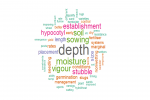-
 Delivering Impact, 15 Mar 2023
Delivering Impact, 15 Mar 2023Want to supercharge your profit? Dual-purpose canola may be just the ticket
CSIRO researchers estimate that adding dual-purpose canola into Australian mixed farming systems has generated more than $1 billion over the past 15 years.
-
 Delivering Impact, 20 Feb 2023
Delivering Impact, 20 Feb 2023New winter wheats add agility in low-rainfall regions
Long-season winter wheats have been trialled to give growers and agronomists in central and southern NSW new data on the opportunities they offer for managing increasingly unpredictable seasons. The research and trials from 2018–20 confirmed the risk-management value, and potential production gains, from varieties able to be sown early and with vernalisation traits that delay flowering until after the frost risk period.
-
 Delivering Impact, 21 Oct 2022
Delivering Impact, 21 Oct 2022Global breeding collaboration pays off in the paddock
A review of the CAIGE program that gives Australian wheat and barley breeders access to international germplasm that is vital to crop improvement has reported a benefit:cost return of 20:1. This assessment reflects the value of international collaborations that are critical to lifting crop yields in the face of climate and other evolving production challenges.
-
 Delivering Impact, 01 Jul 2022
Delivering Impact, 01 Jul 2022Adding value to Australia's canola industry
Australian grain growers have increasingly embraced canola as a profitable winter crop option with annual plantings tripling over the past 20 years to almost three million hectares. Growers now produce more than six million tonnes of canola per season, contributing well over $3 billion to the national economy each year.
-
 Delivering Impact, 01 Jul 2022
Delivering Impact, 01 Jul 2022Mitigating the impact of blackleg in canola
The Australian canola industry has grown rapidly over the past few decades, from a few thousand tonnes in the early 1990’s to more than six million tonnes in the 2021/22 season. Now an intrinsic part of Australian cropping landscapes, canola provides both genetic and financial diversity in Australian grains farming systems that are otherwise heavily reliant on cereals.
-
 Delivering Impact, 01 Jul 2022
Delivering Impact, 01 Jul 2022Supporting long-term control of cereal rusts
Wheat and barley rusts are prevalent in Australia. They are highly infective diseases that can spread widely and quickly within and between regions and have the potential to cause significant crop damage.
-
 Delivering Impact, 01 Jul 2022
Delivering Impact, 01 Jul 2022Investing in water use efficiency yields results
One of the greatest barriers to improving farm productivity in Australia is water. Not simply a lack of it or variations in the timing and intensity of rainfall events, but efficiently capturing, storing and converting every millimetre into plant biomass and grain yield.
-
 Delivering Impact, 01 Jul 2022
Delivering Impact, 01 Jul 2022Ensuring yield benefits through informed fertiliser decisions
Deep placed phosphorus (P) has become an important consideration for growers when planning a fertiliser strategy, with the growing recognition that it can offer long-term yield benefits in many environments and growing conditions.
-
 Delivering Impact, 01 Jul 2022
Delivering Impact, 01 Jul 2022GRDC investment in lupin breeding underpins productivity
Lupin crops deliver valuable productivity benefits by reducing the need for nitrogenous fertiliser, providing disease breaks and boosting cereal yields.
-
 Delivering Impact, 01 Jul 2022
Delivering Impact, 01 Jul 2022Improving seasonal forecasting
Improved seasonal forecasts are an essential part of helping Australian producers manage climate risk and successfully mitigate the impact on farm production and income.
-
GRDC News
+
GRDC News

Investments target ‘new normal’ of mouse activity
The ongoing threat of mouse activity to Australian grain growers is the focus of two...

Triple fungicide resistance detected in Yorke Peninsula barley
Yorke Peninsula barley growers should review their disease management practices after samples of the fungus...

Regional panels recognise industry talent
GRDC honours standout contributors to Australian grains research with Seed of Light and Emerging Leader...

Industry consultant honoured with GRDC award
The 2025 northern GRDC Seed of Light has been awarded to Independent Consultants Australia Network...

Team Fat Farmers on the run
At a GRDC Grains Research Update – Adelaide, a number of attendees rose early to...

Markets, tech and trust take centre stage at Updates
GRDC Grains Research Update events provide important insights into advances in agricultural research, but also...

Agtech momentum building on startups investment
GRDC’s GrainInnovate venture capital fund has been calculated to benefit Australian grain growers to the...

The NGN delivers large gains to growers
Locally relevant research impacts generated through GRDC’s National Grower Network has been found to deliver...
ADVERTISEMENT -
Agronomy
+
Agronomy

Request the data
When considering new varieties, requesting independent data is important.

Impact of NVT extends beyond variety selection
The National Variety Trials (NVT) system adds value to the agricultural research pipeline in ways...

‘Good’ decisions to realise nitrogen benefit
The GRDC Riskwi$e initiative indicates that ‘good’ nitrogen application decisions based on sound analysis will...

Soil amelioration needs a customised approach
Western Australian study urges caution in soil amelioration practices, highlighting the need for soil-specific strategies...

2024 frosts in SA underline need for management rethink
South Australian grain growers faced devastating frost damage in 2024, prompting experts to emphasise the...

Oats offer risk management options for frost-prone areas
With their natural frost tolerance and capacity to be deep sown, oats offer a reduced...

To plant, or not, on late summer rain?
Higher returns are possible from a farming system that can flexibly optimise sowing opportunities throughout...

Managing waterlogging is a long road travelled
Working with South Coast NRM on a GRDC-supported National Grower Network project, the Marold family...

Big booms become the norm on Canada’s western plains
While 40-metre booms are becoming more popular in Canada, they do create challenges as Canadian...

World-first solution to combat spray drift saves growers time, money
The Weather and Networked Data (WAND) system, a pioneering Australian-developed weather data technology, has been...
ADVERTISEMENT -
Grower stories
+
Grower stories

Winter season starts
Every year, GroundCover™ tracks a group of growers throughout Australia as they navigate the cropping...

Time to reflect as growers weigh up mostly positive harvest results
Grain growers from across Australia report on how the season is progressing as they gear...

Difficult finish highlights diversity’s value
Southern NSW grain grower Zach McRae and his agronomist Heidi Gooden of Delta Ag Lockhart...

Pros and cons of cropping intensity meet at Goondiwindi
Northern Farming Systems research has tested various systems across the past decade, but a standout...

Fallow paddocks help improve low-rainfall prospects
Fallow is a crucial moisture management tool that helps boost wheat yields for low-rainfall growers...

Futureproofing weed management
Data for future weed solutions is being collected by Terry Antonio and his SwarmBot

Agile ‘moisture farmer’ turns flood pain into flood gain
A Victoria grain and sheep producer takes the good with the bad when floods arrive,...

Winter canola proves profitable at Weatherboard
Ben Findlay’s farm near Weatherboard, Victoria, utilises ungrazed winter canola, specifically the hybrid RGT Nizza...
ADVERTISEMENT -
Weeds, pests and diseases
+
Weeds, pests and diseases

Trials target spiny emex
Investment by the Grains Research and Development Corporation (GRDC) has investigated opportunities to expand lentil...

The future of the double-knock
An expert in weeds management has outlined a potential approach for dealing with glyphosate and...

Growers warned of increased mouse activity
The National Mouse Group warns of increased mouse activity reports in the Darling Downs and...

Aphids and virus risks elevate need for canola vigilance
Young canola plants may be more susceptible to virus infections this season as green peach...

Economics of disease control options tested
Trials are seeking to refine the management of Ascochyta blight and Botrytis grey mould in...

The climate component of disease risk
Agriculture Victoria is working with SARDI’s Climate Applications research group led by Dr Peter Hayman...

Essential tips to start and keep going
A farm biosecurity plan is an essential investment in your farm’s resilience, productivity and reputation....

Healthy seeds crucial for successful winter sowing
Infected seeds can introduce hidden threats, so securing clean, healthy seeds is crucial to protect...

Herbicide-tolerant lentils: Registration and impacts
The rise of lentils as the most profitable crop in southern rotations was enabled by...

Grains industry scores A-plus for chemical residue compliance
Australia’s grains industry has a 99.2 per cent compliance rate with national maximum residue limits...
ADVERTISEMENT -
Crops
+
Crops

Hardy barley proves its worth in rotation trials
Long-term farming systems experiments support barley as a profitable inclusion in canola and wheat rotations

Award-winning crop takes topsy-turvy seasonal conditions in its stride
Minhamite grower Tim Whitehead has won a GRDC Hyper Yielding Crops initiative award for his...

Looking towards the future of chickpea breeding research
GRDC will soon start the process of identifying a new chickpea breeding partner as part...

Small beans, big benefits
Legumes are often overlooked in many people’s diets, but they are a nutritional powerhouse. Packed...

Northern growers and researchers pushing the canola envelope
Canola’s place in the north is being explored via a GRDC National Grower Network project...

Understanding canola establishment to optimise yields
Establishment of any crop is foundational to its performance and, ultimately, its yield. A major...

Brainstorming with other growers a path to progress
Minhamite grower Tim Whitehead has won a GRDC Hyper Yielding Crops initiative award for his...

Decline in wholegrain bread
Australian Dietary Guidelines recommend that Australian adults eat six servings of grains daily, preferably as...
ADVERTISEMENT -
Innovation
+
Innovation

High-tech robotics and old-tech sheep lessen weeds and worries
While new weed technologies have a place, sheep are also important in risk-proofing a property...

Autonomy proves a game changer
Speaking at a GRDC/Society of Precision Agriculture Australia webinar, Tom Longmire said a SwarmFarm robot...

Software breakthroughs powering new genetic discoveries
With GRDC investment, Analytics for the Australian Grains Industry (AAGI) has developed CoreDetector, a software...

Economics stack up for wheat breeding investment
CAIGE, a global program evaluating bread wheat germplasm suitable for Australian growers, has delivered a...

Biotech’s role in a changing climate
Biotechnology has a critically important contribution to make as the agricultural sector produces more from...

Grains steps up preparations for GHG monitoring
With the grains industry, like agriculture more broadly, facing increasing pressure to know its carbon...

Digital Agronomist helps unlock data
DataFarming’s Digital Agronomist boosts crop productivity with NDVI imagery, soil mapping, and variable-rate tech. Supported...

Genetic diversity matched to different farming system
The Grains Research and Development Corporation (GRDC) has invested in pulse phenology research led by...
ADVERTISEMENT -
Farm business
+
Farm business

Family enterprise grows with new energy and ideas
With succession on the cards, the Joneses reflect on practices that have improved soils and...

Succession a time to reflect on progress
Jodie and Jeff Jones borrowed a header for their first harvest. Two decades on, with...

Ten tips to reduce the risk of harvester fires this season
Recent GRDC Harvester Set-up Workshops run across Australia’s grain growing regions have highlighted the importance...

Selecting grain protectants this harvest
GRDC's latest cereal protectants offer enhanced pest management. Key for growers: rotating Spinosad, Deltamethrin, Fenitrothion,...

Seeds need cool, dry conditions, no matter the variety
As investment in on-farm storage grows, new research shows why it is critical to maintain...

Give grain storage a pre-harvest health check
GRDC Grain Storage Extension team project lead Chris Warrick said the biggest challenge of storing...
ADVERTISEMENT